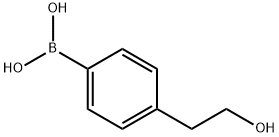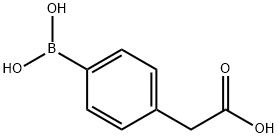Phenylacetic acid-4-boronic acid pinacol ester
Synonym(s):2-(4-(4,4,5,5-Tetramethyl-1,3,2-dioxaborolan-2-yl)phenylacetic acid;Phenylacetic acid-4-boronic acid pinacol ester
- CAS NO.:797755-07-8
- Empirical Formula: C14H19BO4
- Molecular Weight: 262.11
- MDL number: MFCD04038755
- SAFETY DATA SHEET (SDS)
- Update Date: 2024-04-08 13:48:25

What is Phenylacetic acid-4-boronic acid pinacol ester?
The Uses of Phenylacetic acid-4-boronic acid pinacol ester
4-(Carboxymethyl)phenylboronic acid pinacol ester
The Uses of Phenylacetic acid-4-boronic acid pinacol ester
4-(Carboxymethyl)phenylboronic acid pinacol ester can be used:
- As an intermediate to prepare hydantoin-derived autotaxin inhibitors.
- As a substrate in the synthesis of reactive oxygen species (ROS)-sensitive and H2O2-eliminating materials by interlinking phenylboronic acid pinacol esters onto β-cyclodextrin.
- To prepare 5-aryl-2-aminopyridine derived FLT3 kinase inhibitors.
Properties of Phenylacetic acid-4-boronic acid pinacol ester
| Melting point: | 165-170°C |
| Boiling point: | 398.2±25.0 °C(Predicted) |
| Density | 1.13±0.1 g/cm3(Predicted) |
| storage temp. | under inert gas (nitrogen or Argon) at 2-8°C |
| pka | 4.24±0.10(Predicted) |
| form | Crystalline Powder or Powder |
| color | White to yellow |
Safety information for Phenylacetic acid-4-boronic acid pinacol ester
| Signal word | Warning |
| Pictogram(s) |
 Exclamation Mark Irritant GHS07 |
| GHS Hazard Statements |
H315:Skin corrosion/irritation H319:Serious eye damage/eye irritation H335:Specific target organ toxicity, single exposure;Respiratory tract irritation |
| Precautionary Statement Codes |
P261:Avoid breathing dust/fume/gas/mist/vapours/spray. P264:Wash hands thoroughly after handling. P264:Wash skin thouroughly after handling. P271:Use only outdoors or in a well-ventilated area. P280:Wear protective gloves/protective clothing/eye protection/face protection. P302+P352:IF ON SKIN: wash with plenty of soap and water. P305+P351+P338:IF IN EYES: Rinse cautiously with water for several minutes. Remove contact lenses, if present and easy to do. Continuerinsing. |
Computed Descriptors for Phenylacetic acid-4-boronic acid pinacol ester
New Products
Tert-butyl bis(2-chloroethyl)carbamate 4-Methylphenylacetic acid N-Boc-D-alaninol N-BOC-D/L-ALANINOL 3-Morpholino-1-(4-nitrophenyl)-5,6-dihydropyridin- 2(1H)-one Furan-2,5-Dicarboxylic Acid Tropic acid DIETHYL AMINOMALONATE HYDROCHLORIDE 1,1’-CARBONYLDIIMIDAZOLE R-2-BENZYLOXY PROPIONIC ACID 1,1’-CARBONYLDI (1,2-4 TRIAZOLE) N-METHYL INDAZOLE-3-CARBOXYLIC ACID (2-Hydroxyphenyl)acetonitrile 4-Bromopyrazole 5-BROMO-2CYANO PYRIDINE 5,6-Dimethoxyindanone 5-broMo-2-chloro-N-cyclopentylpyriMidin-4-aMine 2-(Cyanocyclohexyl)acetic acid 4-methoxy-3,5-dinitropyridine 2-aminopropyl benzoate hydrochloride 1-(4-(aminomethyl)benzyl)urea hydrochloride diethyl 2-(2-((tertbutoxycarbonyl)amino) ethyl)malonate tert-butyl 4- (ureidomethyl)benzylcarbamate Ethyl-2-chloro((4-methoxyphenyl)hydrazono)acetateRelated products of tetrahydrofuran







You may like
-
![2-[4-(4,4,5,5-Tetramethyl-1,3,2-dioxaborolan-2-yl)phenyl]acetic Acid CAS 797755-07-8](https://img.chemicalbook.in//Content/image/CP5.jpg) 2-[4-(4,4,5,5-Tetramethyl-1,3,2-dioxaborolan-2-yl)phenyl]acetic Acid CAS 797755-07-8View Details
2-[4-(4,4,5,5-Tetramethyl-1,3,2-dioxaborolan-2-yl)phenyl]acetic Acid CAS 797755-07-8View Details
797755-07-8 -
 4-(Carboxymethyl)phenylboronic acid pinacol ester CAS 797755-07-8View Details
4-(Carboxymethyl)phenylboronic acid pinacol ester CAS 797755-07-8View Details
797755-07-8 -
 1975-50-4 98%View Details
1975-50-4 98%View Details
1975-50-4 -
 2-HYDROXY BENZYL ALCOHOL 98%View Details
2-HYDROXY BENZYL ALCOHOL 98%View Details
90-01-7 -
 2-Chloro-1,3-Bis(Dimethylamino)Trimethinium Hexafluorophosphate 221615-75-4 98%View Details
2-Chloro-1,3-Bis(Dimethylamino)Trimethinium Hexafluorophosphate 221615-75-4 98%View Details
221615-75-4 -
 14714-50-2 (2-Hydroxyphenyl)acetonitrile 98+View Details
14714-50-2 (2-Hydroxyphenyl)acetonitrile 98+View Details
14714-50-2 -
 118753-70-1 98+View Details
118753-70-1 98+View Details
118753-70-1 -
 733039-20-8 5-broMo-2-chloro-N-cyclopentylpyriMidin-4-aMine 98+View Details
733039-20-8 5-broMo-2-chloro-N-cyclopentylpyriMidin-4-aMine 98+View Details
733039-20-8
Statement: All products displayed on this website are only used for non medical purposes such as industrial applications or scientific research, and cannot be used for clinical diagnosis or treatment of humans or animals. They are not medicinal or edible.